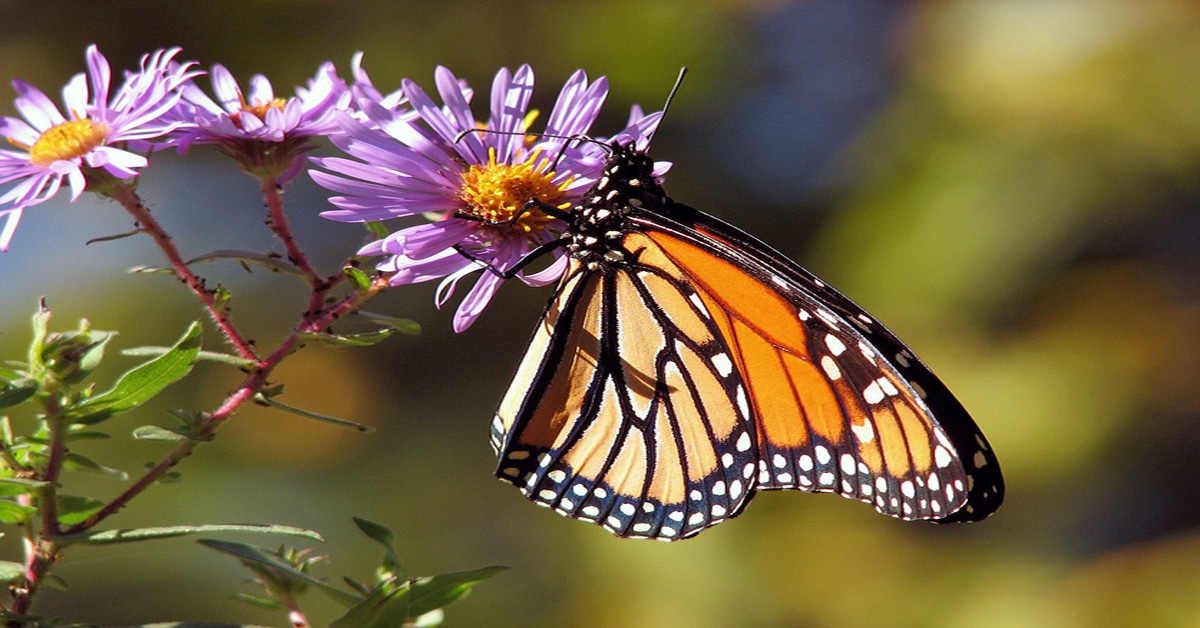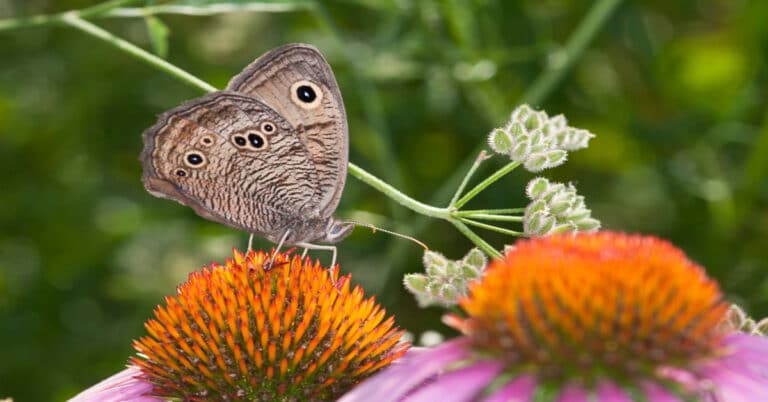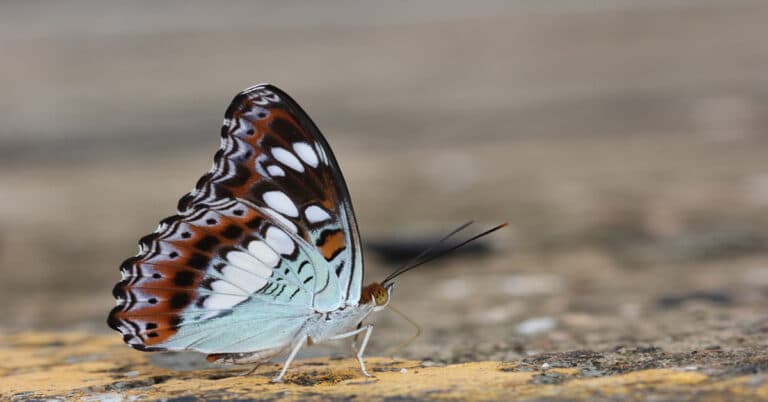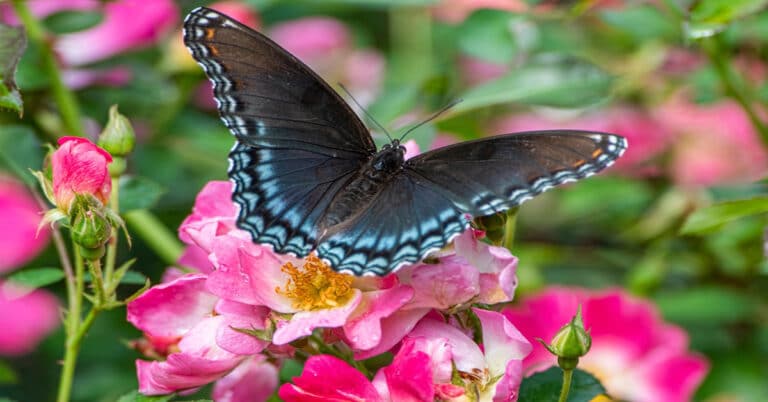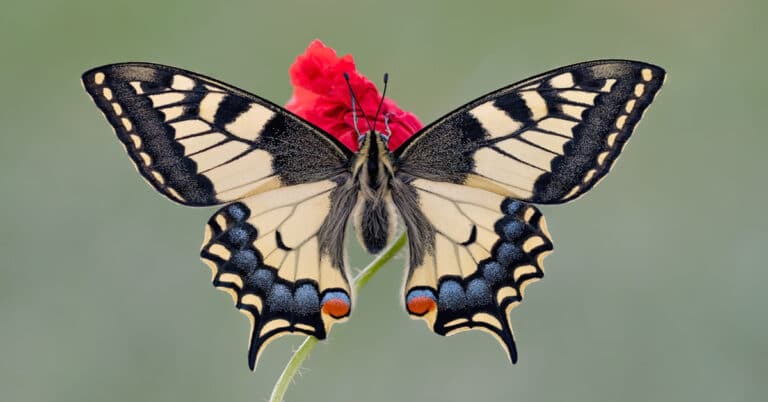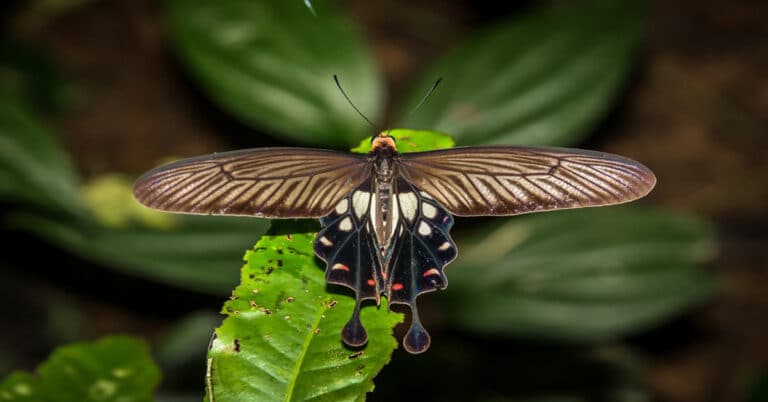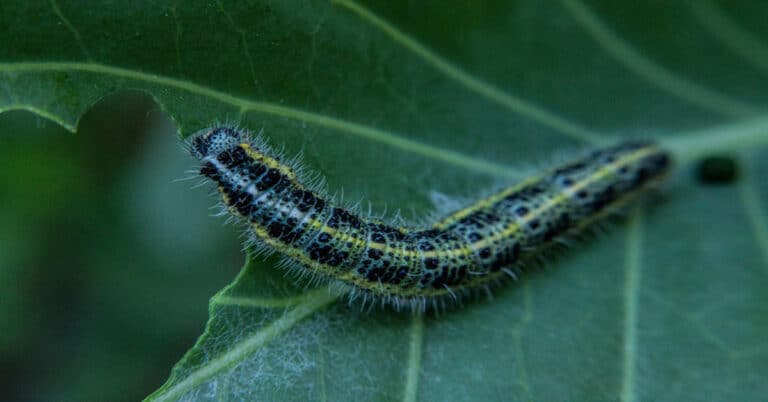Monarch Butterfly – The King of Butterflies and His Royal Family
The word monarch comes from the Greek words for one ruler. A human monarch is a king or queen who rules alone, without necessarily having to consult any other person though good ones have always surrounded themselves with people who could give them good advice. When human monarchs were selected (rather than simply inheriting their positions) they were usually chosen as being the strongest, smartest, and toughest people in their group.
Some monarch butterflies are able to fly for a migration of 2500 miles. Most of them can find their way to their ancestor’s winter homes when they go there and then find their way back to the places they left in spring. This ability made them seem like the strongest, smartest, and toughest of all butterflies. In much of their range, they are also the biggest butterflies, with wingspans up to four inches (10cm). The monarch was the King of Butterflies in the same sense that the lion was the King of Beasts.
The scientific name for monarch butterflies is Danaus plexippus. Credit for this name goes to Carolus Linnaeus, who invented our modern system for scientific names. The names he used often came from names other scientists had used. The reasons why they chose the names they did were not usually explained and can be hard to guess. The first species described were often named after people in ancient Greek and Roman literature. Danaus and Plexippus were the names of two legendary kings in ancient Greece.
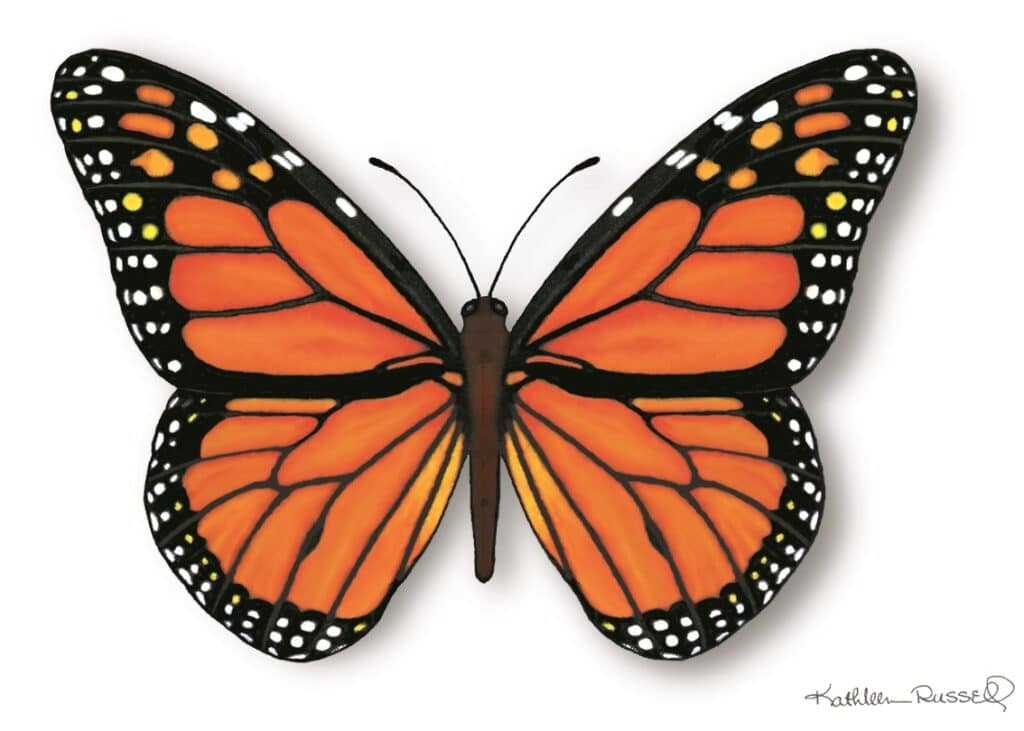
Two other tidbits of trivia may have influenced the naming of this species. During the time when American wildlife was beginning to be studied, and Carolus Linnaeus was working out his taxonomic systems, one of the kings of England was called William of Orange. In addition to King Danaus, another character in Greek literature was Danae, who received a gift of gold coins.
The most common names for this species in Spanish (mariposa monarca) and French (papillon monarque) are similar to its most common name in English.
Another name that has sometimes been used for the Monarch Butterfly is Milkweed Butterfly, because the young butterflies eat milkweed leaves and the adults drink milkweed nectar. (Milkweed has white, milky-looking sap.)
Because of its long travels and wide distribution, this butterfly is also sometimes called The Wanderer. Most monarch butterflies normally live in North America, but storm winds have blown them across the oceans to other continents. They are often found in Australia and southeastern Asia, and sometimes in Africa, Britain, and Europe.
Because of its color, the monarch butterfly has sometimes been called Black-Veined Brown or Common Tiger.
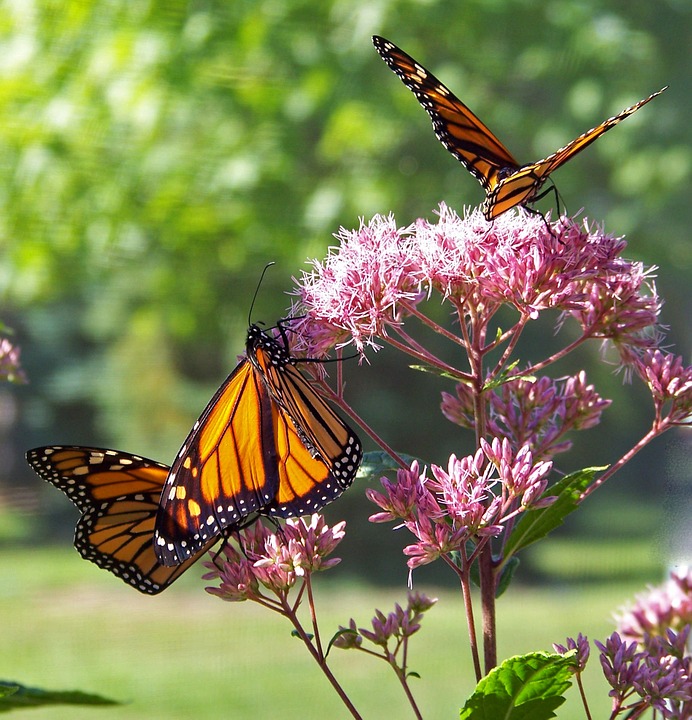
Other Monarchs and Look-Alikes
Other species in the genus Danaus are called Tigers, Wanderers, or Monarchs, and D. gilippus, which is found in the central States, is usually called the Queen. Some of these butterflies migrate, but not nearly so far as D. plexippus does. The South American Monarchs look almost exactly like their North American cousins, but have a distinct, incompatible genetic pattern.
The Jamaican Monarchs have orange wings with slightly darker, rather than black, wing veins. The species sometimes called African Monarchs have less conspicuous dark veins than the American species, and the species called Indian Monarchs have more conspicuous black veins. The Queen’s wings are usually a duller, browner shade of orange overall, with less noticeable dark veins.
Most butterflies in this genus are orange, black, and white. Some are mostly black. On the Hawaiian island of Oahu about one out of ten monarch butterflies is mostly white, with black veins and patches where other monarchs have them, but white where other monarchs have orange markings. These ‘White Monarchs’ differ from other monarchs only in color.
Monarch Butterfly are not closely related to the Tiger Swallowtails, another group of large butterflies whose wings are usually black and lemon-yellow, rather than black and orange-brown. Monarch and Swallowtail caterpillars, like the butterflies, are never confused by people who see them often, but easily confused by people who read descriptions of them. A few Swallowtail species are even bigger than the Monarchs. Most are smaller, and their tiger striping does not follow their wing veins (and thus looks more like a tiger’s stripes).
Monarch Butterfly are most easily confused with a smaller butterfly in the Admiral group called Limenitis archippus, the Viceroy. While flying, Monarchs and Viceroys look very similar. Both are distasteful (even mildly poisonous) to birds that eat them; each absorbs different toxins from the plants on which they feed. When they are at rest and can be clearly seen, the Viceroys have different patterns of wing venation as well as being smaller than Monarch Butterfly.
Nevertheless, they clearly get some survival benefit from their resemblance to the Monarch group; in places where Queen butterflies are common, Viceroys tend to look more like Queens, and in places where only Monarchs are common, Viceroys look like Monarchs.
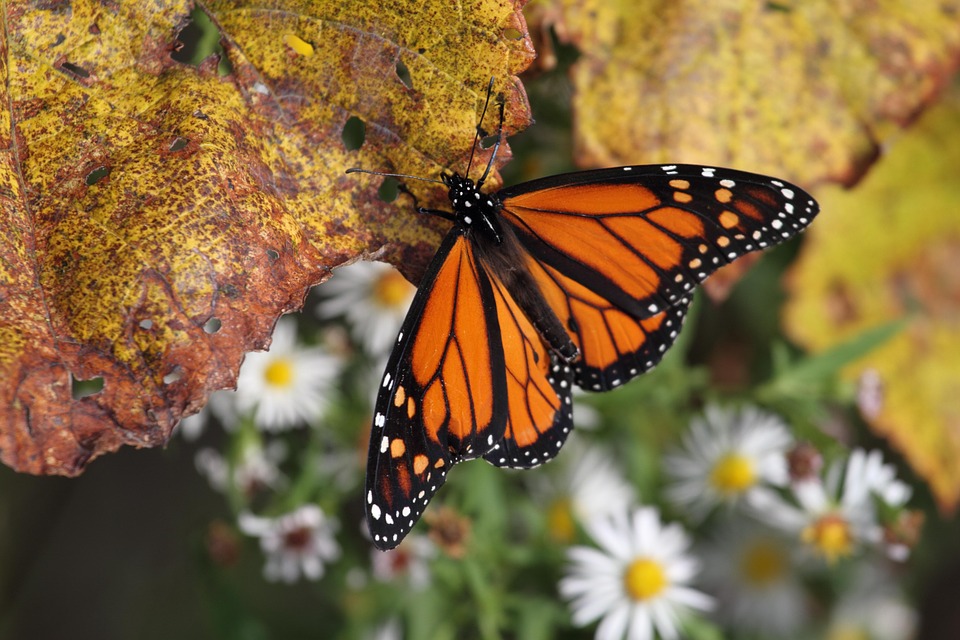
Monarch Butterfly Lives
Monarch butterfly are still quite common, although their numbers have declined recently. They are a species of special concern to many Americans whether their populations are threatened or not.
Most individual butterflies fly for only a few weeks. Monarch butterfly are less exceptional than people used to think; they typically go through four generations in one year. Only one of these generational groups has to migrate and hibernate (and some tropical populations don’t migrate). The others live fast, as typical butterflies do. They develop through four distinct shapes, with a total of eight distinct outer surfaces.
They typically spend three to eight days gestating inside eggs, three to five days in each of five larval instars (caterpillar skins), a week or two resting and reshaping inside the chrysalis (the pupal phase), and five to seven weeks flying about as adult butterflies. Despite some overlap among generations, the butterflies have no noticeable social instincts and show no recognition of their offspring, if they ever do see them.
Compared with other butterflies Monarchs tend to fly slowly, at a pace some people compare to jogging or sailing. In a quiet place, you can hear each flap of their relatively big, solid wings.
Though unable to move in cold air and helpless against gusts of wind, Monarchs show a definite sense of purpose. Usually, it’s easy to tell where a Monarch butterfly is going. They fly from one flower to another, fly to a branch to rest, or fly to a puddle to sip water.
Females fly from one milkweed plant to another, doing their best to give each egg a separate food plant. (A typical female Monarch lays about a thousand eggs, and if she can find a thousand milkweed plants she may place each egg on a different plant.) Males chase and play-fight with females, sometimes even knocking them to the ground; adult Monarchs’ fights never seem to do any of them any real harm.
Most monarch butterflies never migrate. Those who do migrate are not infallibly guided to their families home territories, as some writers have suggested. They can be blown off course and spend winters in places other than the ones that seem to have been their goals. Barbara Kingsolver’s science fiction novel, Flight Behavior, reflected the fact that monarchs who were probably heading for Mexico have spent whole winters as far north as Virginia Beach. Nevertheless, close observation has shown that many monarch butterflies find their way, not only to the same place where their great-grandparents hibernated but to the same individual tree.
Migration is very strenuous for the monarch butterflies who do it. Individuals who have hibernated all winter look thin and tired, and produce fewer and smaller eggs than those who have not hibernated. During the winter, while they rest and conserve their energy, the biochemicals that make them indigestible begin to break down, and some are eaten by mice and birds. Not all hibernating butterflies are able to fly back to their homes in spring; some die during the winter or before flying north in spring. Migration thins local Monarch butterfly populations every year. During the summer populations become denser, then thin out again in the winter.
Threats to this abundant and popular butterfly species come from habitat loss, food plant destruction, heavy use of insecticide sprays and germ warfare against caterpillars, and an invasive nuisance plant that the caterpillars don’t recognize as non-food for them. Bioengineered corn and soybeans should theoretically have had no effect on Monarch butterfly populations since they don’t eat corn or soybeans…but heavy use of chemical pesticides, and destruction of the Monarchs’ own place in the environment, have significantly reduced populations in some areas.
Overview
Monarch butterflies possess colorful wings and are one of the most recognizable species of butterflies. These butterflies have 2 sets of wings that can stretch up to four inches. The color of their wings is a shade of deep orange with black borders and white spots over them.
Male Monarchs have two black spots near their hind wings, whereas females lack these spots. The reason for these black spots is for the male to attract female butterflies for mating.
You will often find these butterflies in the open fields and meadows. Their favorite time to come out is spring and summer, the same time when their populations increase. This is when a monarch butterfly’s lifecycle begins. They populate Northern America, and in winters, they may migrate to some parts of Mexico.
Monarch Butterfly Life Cycle
There is a major reason you will often find many monarch butterflies near the milkweed meadows. It is simply because milkweed is the only plant that can host their caterpillars. Therefore, the female butterflies only lay their eggs on milkweed plants.
At a time, a monarch butterfly can lay between 300-and 500 eggs. All of the eggs are attached with the help of a secret glue monarch butterfly uses to keep eggs from brushing off the plant.
After a few days (usually 3-5 days), the eggs hatch. After the caterpillars are out, they feed on their empty egg cases and milkweed plants. These caterpillars spend most of their time eating. After eating for 2 weeks, they begin to prepare for the next stage of the monarch butterfly life span, called the pupa stage.
They begin to spin a protective case around them, and just after two weeks, they complete their metamorphosis stage and come out as fully grown adult butterflies. The next step for these butterflies depends heavily on the season they complete their metamorphosis stage.
If these adult butterflies come out in spring or summer, they begin to reproduce within weeks. But if they get out of the stage in the fall season, they prepare themselves for winter and start to migrate to find warmer grounds.
Monarch Butterfly Migration
For winters, these monarch butterflies migrate thousands of miles to find suitable habitats. Many researchers find this migration fascinating. The butterflies can fly from America to Central Mexico forests to hibernate. These butterflies often travel 50-100 miles every day, and monarch butterfly migration may take up to 2 months.
On their journey, these butterflies feed on flower nectar and lay eggs on different milkweeds. They finally rest in the Oyamel Fir Forest of Mexico, hibernating throughout the winter. The lifespan of monarch butterflies is short, consisting of not more than just 9 months. The monarch butterflies’ lifecycle starts again as they migrate back to the U.S. after winter.
Monarch butterfly migration tourism is rising. The Mexican government has applied a few protocols that help keep the butterflies safe and allow travelers to see them in the breath-taking beauty of the forest.
Monarch Butterfly Decline
Since 1990, there has been a constant decline in the population of monarch butterflies. Statistics indicate that it has fallen over 90% during the period. One of the core explanations is the decline in habitat in U.S.A and Mexico due to deforestation.
Apart from that, pesticides and herbicides kill the plants. There has also been an increase in insecticides that have proven dangerous for monarch butterflies. The increase in these dangerous developments has forced people to demand saving milkweed and saving monarch butterflies. Many others have called to help monarch butterfly save their habitat and have a sustainable population.
Even the drastic weather change has contributed to lowering the monarch butterfly population. Therefore, there has to be a focus on combating global warming and climate change to keep these butterflies safe.
How to Rear Monarch Butterfly
Many people love to keep these monarch butterflies as pets due to their astounding beauty. You first need to retrieve the eggs from the milkweed plant and bring them inside to provide them a better chance of surviving. Make sure you keep the eggs in a pot or a safe place where they are away from dangers.
Also, ensure to provide the caterpillars with lots of milkweeds to help them grow. You can even transfer them to a milkweed plant once they have grown up and feel agitated to leave the container. Before you grow a monarch butterfly, make sure you have all the necessary equipment.
Monarch Butterfly Facts
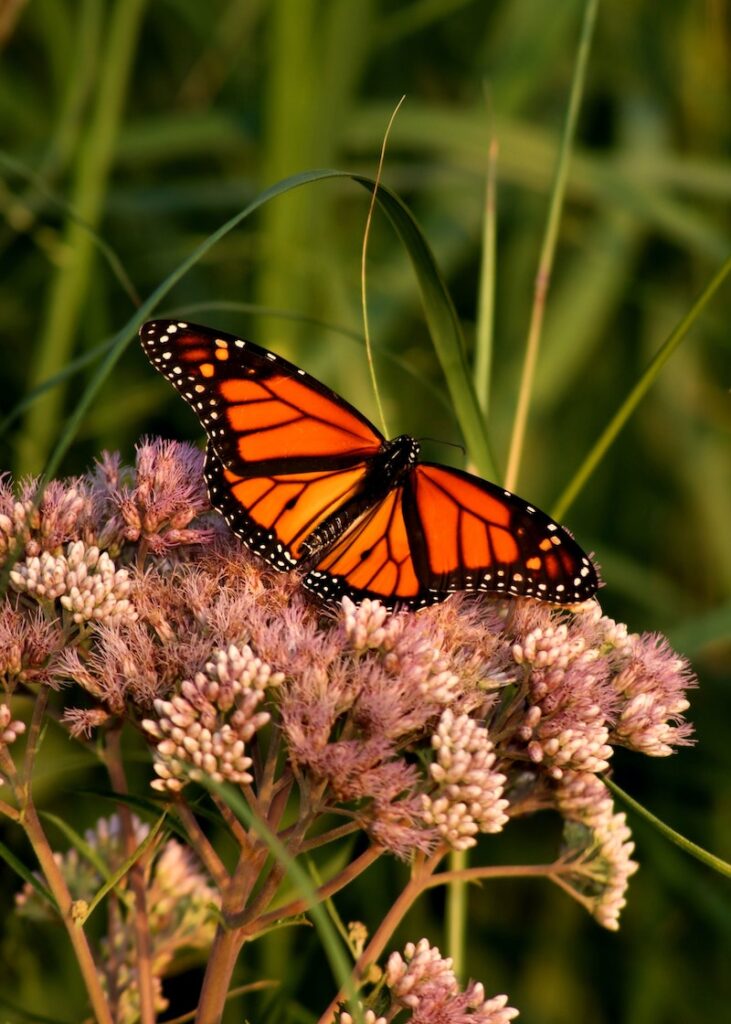
- They travel a staggering 3000 miles every year by the end of their lifecycle.
- The caterpillars are keen eaters and eat up to 200 times their size
- Monarch butterflies first emerged in Australia in 1871
- They are fast growers and only take a couple of weeks to become an adult butterfly
- They are one of the most beautiful species of butterflies
- These butterflies are pretty and poisonous, although the poison is not life-threatening.
- It is a State insect of five U.S.A. states
Final Thoughts
Monarch butterflies are fascinating creature that roams the U.S and Mexico with their vibrant wings. The monarch butterfly’s lifecycle is also fascinating, especially the development of caterpillars.
Frequently Asked Questions
Still, want to learn more about monarch butterfly lifecycle and their life? Below we have answered a few frequently asked questions.
What Does Monarch Butterfly Eat?
As caterpillars and small insects, they feed on the milkweed. Meanwhile, the adult monarchs love to feed on the flower’s nectar. It is important to know that not all milkweeds are suitable for monarch butterflies.
Are Monarch Butterfly Poisonous?
Monarch butterflies can prove to be highly poisonous and toxic. Although they don’t have natural poison within themselves, it comes from the food they consume.
Is it Safe to Touch a Monarch Butterfly?
Yes, it is safe to pick it up but make sure to pick it up with 4 wings carefully.
Where Can I Find Monarch Butterfly Coloring Pages
Learnaboutnature.com provides the free Monarch Butterfly Coloring Pages. We hope you like them!
Where Can I Purchase A Butterfly Kit For Children?
You can find click here to find out about Butterfly kits for children.

Nato is a content writer and researcher with a background in psychology who’s eager to explore the wonders of nature. As a travel enthusiast and animal lover, she hopes to inspire others to discover and cherish the beauty and importance of the natural world.

